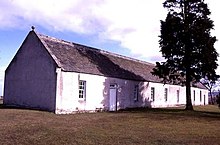
Church architecture refers to the architecture of buildings of churches, convents, seminaries etc. It has evolved over the two thousand years of the Christian religion, partly by innovation and partly by borrowing other architectural styles as well as responding to changing beliefs, practices and local traditions. From the birth of Christianity to the present, the most significant objects of transformation for Christian architecture and design were the great churches of Byzantium, the Romanesque abbey churches, Gothic cathedrals and Renaissance basilicas with its emphasis on harmony. These large, often ornate and architecturally prestigious buildings were dominant features of the towns and countryside in which they stood. However, far more numerous were the parish churches in Christendom, the focus of Christian devotion in every town and village. While a few are counted as sublime works of architecture to equal the great cathedrals and churches, the majority developed along simpler lines, showing great regional diversity and often demonstrating local vernacular technology and decoration.

Rathven is an ecclesiastical parish, village and former civil parish in the historic county of Banff, now in Moray, Scotland. The civil parish was last used as a census subdivision in 2001 when the population was 12,378, The former burgh of Buckie is the largest settlement in the parish, which also includes Findochty and Portknockie.
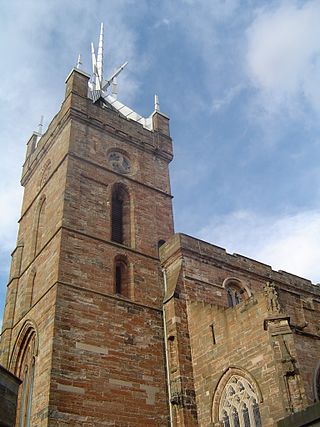
St. Michael's Parish Church is one of the largest burgh churches in the Church of Scotland. It is one of two parishes serving the West Lothian county town of Linlithgow, the other being St. Ninian's Craigmailen. St Michael is the town's patron saint; the town's motto is "St Michael is kinde to strangers".
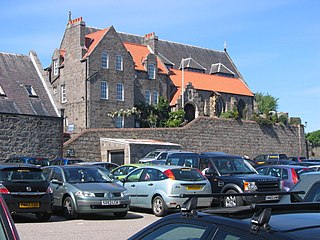
St Margaret of Scotland — also known as St Margaret's, Gallowgate — is a Scottish Episcopal Church, in Aberdeen, Scotland.

St Andrew's Cathedral, or the Cathedral Church of Saint Andrew, is a cathedral of the Scottish Episcopal Church situated in the Scottish city of Aberdeen. It is the see of the Bishop of Aberdeen and Orkney, who is the Ordinary of the Diocese of Aberdeen and Orkney.
Events from the year 1755 in Great Britain.

St Ninian's Cathedral in Perth is a cathedral of the Scottish Episcopal Church in the Diocese of St Andrews, Dunkeld and Dunblane.

Portgordon, or sometimes Port Gordon, is a village in Moray, Scotland, 2 km south-west of Buckie. It was established in 1797 by Alexander Gordon, 4th Duke of Gordon as a fishing village. It had a population of 844 at the time of the 2011 census. Currently the Portgordon Community Harbour Group is trying to regenerate the harbour and open a marina.
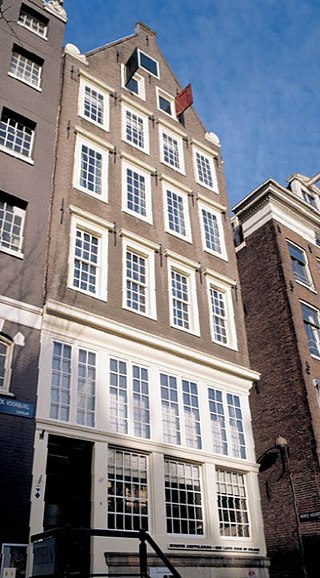
A clandestine church, defined by historian Benjamin J. Kaplan as a "semi-clandestine church", is a house of worship used by religious minorities whose communal worship is tolerated by those of the majority faith on condition that it is discreet and not conducted in public spaces. Schuilkerken are commonly built inside houses or other buildings, and do not show a public façade to the street. They were an important advance in religious tolerance in the wake of the Reformation, an era when worship services conducted by minority faiths were often banned and sometimes penalized by exile or execution.

St Michael's Roman Catholic Church, Linlithgow is situated in the historic town of Linlithgow. The present church is situated at the East end of the town near the Low Port. It is located beside the banks of Linlithgow loch and close to the old palace where Mary Queen of Scots was born. Next to the palace is the Parish Church of St Michael's the original seat of the Catholic Church prior to the reformation. This brief history chronicles the Catholic Church in Linlithgow from inception to the present day.
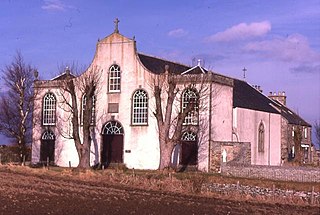
St. Gregory's Church is a Roman Catholic church at Preshome near Buckie in north-east Scotland. It is protected as a category A listed building.

Church architecture in Scotland incorporates all church building within the modern borders of Scotland, from the earliest Christian structures in the sixth century until the present day. The early Christian churches for which there is evidence are basic masonry-built constructions on the west coast and islands. As Christianity spread, local churches tended to remain much simpler than their English counterparts. By the eighth century more sophisticated ashlar block-built buildings began to be constructed. From the eleventh century, there were larger and more ornate Romanesque buildings, as with Dunfermline Abbey and St Magnus Cathedral in Orkney. From the twelfth century the introduction of new monastic orders led to a boom in ecclesiastical building, often using English and Continental forms. From the thirteenth century elements of the European Gothic style began to appear in Scotland, culminating in buildings such as Glasgow Cathedral and the rebuilt Melrose Abbey. Renaissance influences can be seen in a move to a low-massive style that was probably influenced by contacts with Italy and the Netherlands.
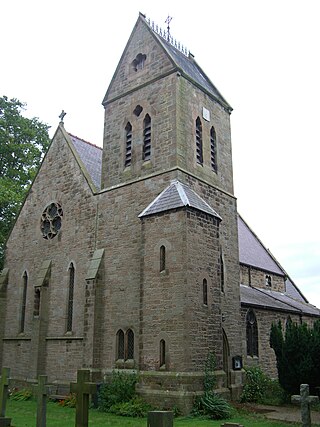
St Ninian’s church is a Catholic place of worship situated on Burnhouse Road in the town of Wooler in Northumberland, England. It is a Grade II listed building and is within the Catholic Diocese of Hexham and Newcastle.
Events from the year 1755 in Scotland.
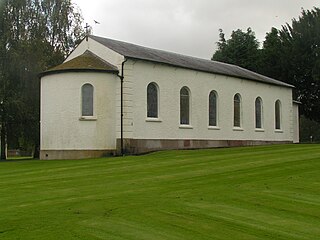
The Church of St Mary and St Michael, Llanarth, Monmouthshire, was built as the family chapel for Llanarth Court. It was the first Roman Catholic church constructed in the county since the Dissolution of the Monasteries in the mid-16th century. Built circa 1790, some decades before the Roman Catholic Relief Act 1829, it was designed to look like an orangery, or barn, in order not to attract anti-Catholic hostility. It is considered one of the oldest, if not the oldest, Catholic churches in Wales.

St Mary's, Fochabers is a Roman Catholic church in the village of Fochabers, Moray, in Scotland and is a part of the RC Diocese of Aberdeen. The building is significant for the high quality of its altar and stained glass windows. It is an active parish church served from Buckie with regular weekly Sunday Mass at 10.00 am.

St Peter's Roman Catholic Church is a large mid-nineteenth century church in Buckie, Moray, Scotland. Known locally as the Buckie Cathedral, it was built between 1851 and 1857, soon after the emancipation of Catholics in Scotland, to provide a place of worship for the local Catholic congregation. It was designed by James Kyle, Catholic bishop of Aberdeen, and built on land donated to the diocese by Sir William Gordon, Baronet of Letterfourie. It was extended and redecorated in the early twentieth century by Charles Ménart, and was designated a Category A listed building in 1972. It remains an active place of worship, under the governance of the Roman Catholic Diocese of Aberdeen.
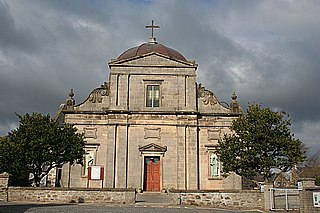
St Thomas's Church is a Roman Catholic church in Keith, in Moray, Scotland. It is a cruciform building, exhibiting features of neoclassical and baroque architecture, with an elaborate east-facing facade, and north and south transepts with stained glass windows. Originally designed by Walter Lovi and William Robertson in the early 1830s, its large copper dome was added in 1916 by Charles Ménart, who also remodelled the interior. It has been designated a Category A listed building.
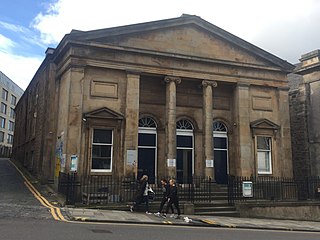
St Oran's Church was a Gaelic-speaking congregation of the Church of Scotland in Edinburgh. Originating in the early 18th-century, the congregation continued until 1948, latterly meeting at Broughton Street.
